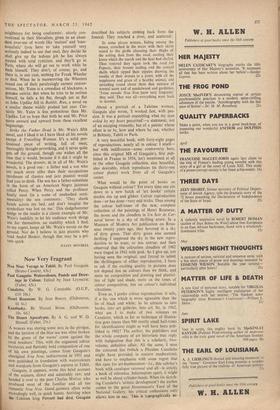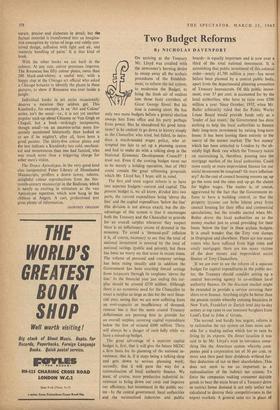Now Very Fragrant
Noa Noa: Voyage to Tahiti. By Paul Gauguin. (Bruno Cassirer, 63s.) Paul Gauguin: Watercolours, Pastels and Draw- ings in Colour. Edited by Jean Leymarie. (Faber, 45s.) Kandinsky. By Marcel Brion. (Oldbourne,
10s. 6d.) '
The Douce Apocalypse. By A. G. and W. 0. Hassall. (Faber, 25s.) 'A WOMAN was storing some nets in the pirogue, and the horizon of the blue sea was often broken by the green of the waves' crests against the coral breakers.' This, with the organised colour territories and flattishly bold composition of one of his own paintings, comes from Gauguin's aboriginal Noa Noa, rediscovered in 1951 and now published in translation with watercolours and woodcuts from Gauguin's sojourn in Tahiti.
Gauguin, it appears, wrote this brief account of the sojourn, direct and admirably raw, and handed it over to the poet Charles Morice, who produced most of the familiar and all too romantic Noa Noa. Good -painters often write exceedingly well, in quick bursts. Arriving when the Tahitian king Poniard had died, Gauguin
described his subjects coming back from the funeral. They reached a river, and scattered:
In some places women, hiding among the stones, crouched in the water with their skirts raised to the girdle cleansing their thighs of the soiling dust from the road, cooling their knees which the march and the heat had chafed. Thus restored they again took the road for Papeete, their breasts leading and the conical shells which tipped their nipples drawing the muslin of their dresses to a point, with all the suppleness and grace of a healthy animal, and spreading round about them that mixture of normal scent and of sandalwood and gardenias. 'Teine merahi Noa Noa (now very fragrant),' they said. That was all—everything went back to mormal.
About a portrait of a Tahitian woman, Gauguin also wrote, `I worked fast, with pas- sion. It was a portrait resembling what my eyes veiled by my heart perceived'—a statement, not of an escaping romantic, but of a painter whose effort is to be, how and where he can, whether in Brittany, Tahiti or Paris.
A very beautiful book, with forty-eight pages of reproductions, nearly all in colour. I smell— but with indifference—some controversy here, since this original MS of Gauguin's, first pith- fished in France in 1954, isn't mentioned at all in the other Gauguin collection, also beautiful, also desirable, which reproduces (in thirty-one colour plates) work from all of Gauguin's career.
What would be the point of books on Gauguin without colour? Yet every time one sits down to a new batch of 'art books' certain doubts rise up and gibber. Colour reproduction does—or has done—very odd tricks. Thus among the colour half-tones of the new, complete collection of the paintings of Henri Rousseau, the moon and the cloudlets in Un Soir de Car- naval hover in a sky of thrilling azure. In a Museum of Modern Art publication on Rous- seau twenty years ago, they hovered in a sky of dirty green. That dirty green also seemed thrilling. I supposed the sky in the new repro- duction to be truer, or less untrue; and then observed that the colourless cloudlets of 1962 were tinged in 1942 with pink. So I give up, not having seen the original; and forced to admit the thrillingness of either reproduction, I have to ask if the exciting quality in pictures does not depend less on colours than we think, and more on composition and drawing and plastici- ties of light and shade, more on the tones of colour composition, less on colour's individual vibrations.
Even so, I prefer colour reproduction. It tells, if a lie, one which is more agreeable than the lie of black and white; its lie attracts us into books, into art galleries, into art. So, in 1962, what am I to make of two volumes on Canaletto, which as far as technique of illustra- tion goes (more than 900 mostly small half-tones for identification) might as well have been pub- lished in 1902? The author, the publishers and the whole company of art historians may reply with indignation that this is a scholarly, two- volume, definitive affair. All the same, I miss the coloured lies (which a Phaidon Canaletto might have provided in austere moderation); and have to emphasise with some regret that this opus for art-businessmen--i.e., this scholar's book with catalogue raisonne and all—is strictly a book of reference. Information apart, it might as well be about cylinder-heads. When (in sketch- ing Canaletto's `artistic development') the author comes to the great Stonemason's Yard of the National Gallery, his critical enthusiasm only allows him to say, 'This is topographically ac- curate, precise and elaborate in detail; but the factual material is transformed into an imagina- tive conception by virtue of large and subtly con- trived design, suffusion with light and air, and masterly handling of paint.' It is that kind of book.
With the other books we are back in the .colours. At any rate, colour processes improve. The Rousseau has fifty colour plates, more than 200 black-and-whites; a useful text, with a happy slap at the Chicago art official who asked a Chicago botanist to identify the plants in these pictures, to show if Rousseau was ever inside a jungle.
Individual books in art series occasionally deserve a mention they seldom get. This Kandinsky, for example, in an 'Art and Colour' series, isn't the usual—i.e., it is not yet another popular suck-up about Cazanne or Van Gogh or Chagall, but a book—strikingly inexpensive, though small—on an ancestor-artist more fre- quently mentioned historically than looked at to see if he mightn't, after all, have been a good painter. The thirty-five colour plates and the text indicate a Kandinsky less cold, mechani- cal and monotonous than one had fancied, who was much more than a triggering charge for other men's vision.
The Douce Apocalypse, in the very good (and also inexpensive) Faber Library of Illuminated Manuscripts, proffers a dozen tawny, solemn, delightful colour reproductions from the thir- teenth-century manuscript in the Bodleian, which is nearly as exciting in miniature as the vast Apocalypse tapestries which now hang in the chateau at Angers. A curt, professional text gives plenty of information.
GEOFFREY GRIGSON



































 Previous page
Previous page